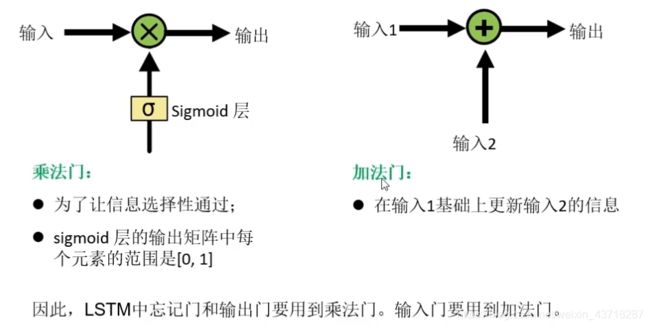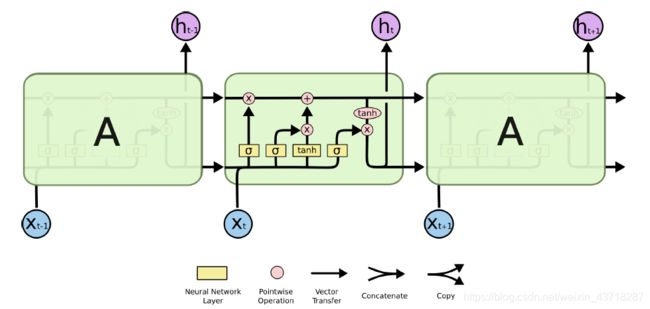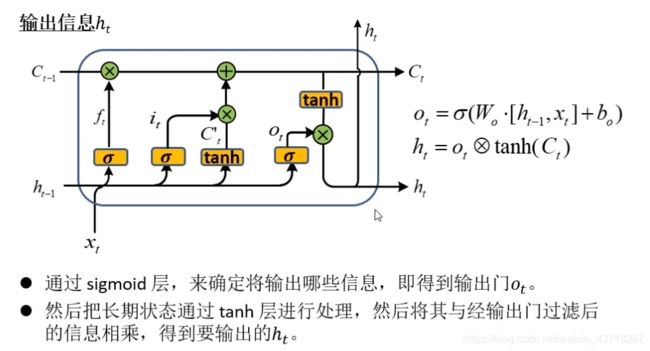Pytorch学习笔记----RNN/LSTM/GRU
Pytorch学习笔记-----RNN
- RNN
-
- RNNCell
- How to use RNNCell
- How to use RNN
- Using RNNCell
- one-hot编码
-
- python列表解析
-
- 基本列表解析
- 条件列表解析
- 嵌套列表解析
- Long Short-Term Memory(LSTM)
-
- LSTM的基本信息
- LSTM的计算过程
- 双向RNN(Bidirectional RNNS)
- GRU
- Example of GRU
-
- 过程
-
- Preparing Data
- Result
- Preference
RNN
Recurrent Neural Network : RNN.
隐藏层之间有连接,是主要用于序列数据的分类,预测等处理的神经网络。
RNNCell
RNN的运行模式是左侧的图,拆分开来为右侧
h(t-1)送入RNNCell求h(t),h(0)代表先验

RNNCell的本质是一个Linear Layer
for x in X:
h=Linear(x,h)
#h(1)=linear(x1,h0)
#h(2)=linear(x2,h1)
可以将两次线性运算转化为一次线性运算,将w_hh和w_ih拼接成一个矩阵,x和h拼接成一个矩阵,做矩阵乘法即可
How to use RNNCell
import torch
batch_size=1
seq_len=3 #输入序列长度为3
input_size=4 #输入数据是3维向量
hidden_size=2 #隐藏层是2维向量
cell=torch.nn.RNNCell(input_size=input_size,hidden_size=hidden_size)
#(seq,batch,features)
#randn()从标准正态分布(均值为0,方差为1)中抽取的一组随机数。返回一个张量
dataset=torch.randn(seq_len,batch_size,input_size)
#返回一个全0的所给维度的张量h0
hidden=torch.zeros(batch_size,hidden_size)
for idx,input in enumerate(dataset):
print('='*20,idx,'='*20)
print("Input size: ",input.shape)
hidden=cell(input,hidden)
print('outputs size: ',hidden.shape)
print(hidden)
How to use RNN
Using RNNCell
one-hot编码
One-Hot 编码,又称为一位有效编码,主要是采用N位状态寄存器来对N个状态进行编码,每个状态都由他独立的寄存器位,并且在任意时候只有一位有效。
One-Hot 编码是分类变量作为二进制向量的表示。这首先要求将分类值映射到整数值。然后,每个整数值被表示为二进制向量,除了整数的索引之外,它都是零值,它被标记为1。


python列表解析
列表推导式提供了一个创建链表的简单途径,每一个列表推导式包括在一个 for 语句之后的表达式,零或多个 for 或 if 语句。返回值是由 for 或 if 子句之后的表达式得到的元素组成的列表。如果想要得到一个元组,必须要加上括号。
基本列表解析
data=[12,2,3,4]
c=[x for x in data] #[12, 2, 3, 4]
d=[x**2 for x in data] #[144, 4, 9, 16]
e=[(x,x**2) for x in data]
#[(12, 144), (2, 4), (3, 9), (4, 16)]
条件列表解析
f=[x*3 for x in data if x%2==0] #[36, 6, 12]
嵌套列表解析
x_data=[1,0,2,2,3]
one_hot_lookup=[[1,0,0,0],
[0,1,0,0],
[0,0,1,0],
[0,0,0,1]]
x_one_hot=[one_hot_lookup[x] for x in x_data]
# [[0, 1, 0, 0], [1, 0, 0, 0], [0, 0, 1, 0], [0, 0, 1, 0], [0, 0, 0, 1]]
Long Short-Term Memory(LSTM)
LSTM的基本信息
LSTM的计算过程
双向RNN(Bidirectional RNNS)
GRU
GRU是LSTM的一种变体,运算速度更快,与LSTM的使用场合分情况而定。

Example of GRU
过程
Preparing Data
编码
 Padding
Padding

创建分类词典
 Embedding
Embedding
(图片有误,填充0后Embedding得到的数值一样)

排序

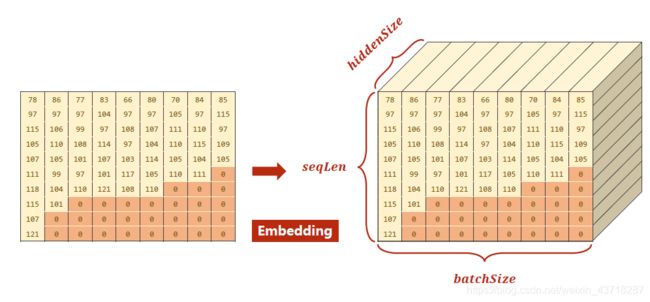 横向取值,表示批量取每个样本的x1,即为名字的第一个字符
横向取值,表示批量取每个样本的x1,即为名字的第一个字符
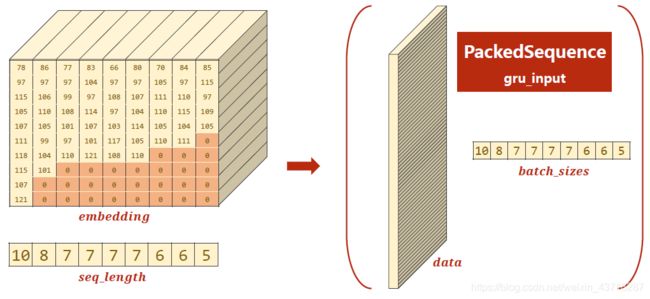
整体代码如下:
import csv
import gzip
import torch
import matplotlib.pyplot as plt
import numpy as np
from torch.utils.data import DataLoader
from torch.utils.data import Dataset
import time
import math
#parameters
HIDDEN_SIZE=100
BATCH_SIZE=256
N_LAYER=2
N_EPOCHS=20
N_CHARS=128
USE_GPU=False
class NameDataset(Dataset):
def __init__(self,is_train_set=True):
filename='names_train.csv.gz' if is_train_set else 'names_test.csv.gz'
with gzip.open(filename,'rt') as f:
reader=csv.reader(f)
rows=list(reader)
self.names=[row[0] for row in rows]
self.len=len(self.names)
self.countries=[row[1] for row in rows]
self.country_list=list(sorted(set(self.countries))) #制作国家名称词典
self.country_dict=self.getCountryDict()
self.country_num=len(self.country_list)
def __getitem__(self, index):
return self.names[index],self.country_dict[self.countries[index]]
def __len__(self):
return self.len
def getCountryDict(self):
country_dict=dict()
for idx,country_name in enumerate(self.country_list,0):
country_dict[country_name]=idx
return country_dict
def idx2country(self,index):
return self.country_list[index]
def getCountriesNum(self):
return self.country_num
trainset=NameDataset(is_train_set=True)
trainloader=DataLoader(trainset,batch_size=BATCH_SIZE,shuffle=True)
testset=NameDataset(is_train_set=False)
testloader=DataLoader(testset,shuffle=False,batch_size=BATCH_SIZE)
N_COUNTRY=trainset.getCountriesNum()
#使用GPU进行计算
def create_tensor(tensor):
if USE_GPU:
device=torch.device("cuda:0")
tensor=tensor.to(device)
return tensor
class RNNClassifier(torch.nn.Module):
def __init__(self,input_size,hidden_size,output_size,n_layers=1,bidirectional=True):
super(RNNClassifier, self).__init__()
self.hidden_size=hidden_size
self.n_layers=n_layers
self.n_directions=2 if bidirectional else 1 #if 为真输出前面表达式的内容,否则输出else后的内容
self.embedding =torch.nn.Embedding(input_size,hidden_size)
self.gru=torch.nn.GRU(hidden_size,hidden_size,n_layers,
bidirectional=bidirectional)
self.fc=torch.nn.Linear(hidden_size*self.n_directions,output_size)
def _init_hidden(self,batch_size):
hidden=torch.zeros(self.n_layers*self.n_directions,
batch_size,self.hidden_size)
return create_tensor(hidden)
def forward(self,input,seq_lengths):
#input shape: BxS -> SxB
input=input.t() #转置
batch_size=input.size(1)
hidden=self._init_hidden(batch_size)
embedding=self.embedding(input)
#pack them up
#It returns a PackedSequence object
gru_input=torch.nn.utils.rnn.pack_padded_sequence(embedding,seq_lengths)
output,hidden=self.gru(gru_input,hidden)
# print(hidden)
if self.n_directions==2:
hidden_cat=torch.cat([hidden[-1],hidden[-2]],dim=1)
else:
hidden_cat=hidden[-1]
fc_output=self.fc(hidden_cat)
return fc_output
def name2list(name):
arr=[ord(c) for c in name]
return arr,len(arr)
def make_tensors(names,countries):
sequences_and_lengths=[name2list(name) for name in names]
#print(sequences_and_lengths)
name_sequences=[s1[0] for s1 in sequences_and_lengths]
seq_lengths=torch.LongTensor([s1[1] for s1 in sequences_and_lengths])
countries=countries.long()
#make tensor of name, BatchSize x Seqlen
#全部填充0然后覆盖
seq_tensor=torch.zeros(len(name_sequences),seq_lengths.max()).long()
for idx,(seq,seq_len) in enumerate(zip(name_sequences,seq_lengths),0):
seq_tensor[idx,:seq_len]=torch.LongTensor(seq)
#sort by length to use pack_padded_sequence
seq_lengths,perm_idx=seq_lengths.sort(dim=0,descending=True)
seq_tensor=seq_tensor[perm_idx]
countries=countries[perm_idx]
return create_tensor(seq_tensor),\
create_tensor(seq_lengths),\
create_tensor(countries)
def trainModel():
def time_since(since):
s = time.time() - since
m = math.floor(s / 60)
s -= m * 60
return '%dm %ds' % (m, s)
total_loss = 0
for i, (names, countries) in enumerate(trainloader, 1):
inputs, seq_lengths, target = make_tensors(names,countries)
output=classifier(inputs,seq_lengths)
loss=criterion(output,target)
optimizer.zero_grad()
loss.backward()
optimizer.step()
total_loss +=loss.item()
if i%10==0:
print(f"[{time_since(start)} Epoch {epoch} ",end="")
print(f"[{i*len(inputs)}/{len(trainset)}] ",end='')
print(f'loss={total_loss/(i*len(inputs))}')
return total_loss
def testModel():
correct=0
total=len(testset)
print("evaluating trained model ...")
with torch.no_grad():
for i,(names,countries) in enumerate(testloader):
inputs,seq_lengths,target=make_tensors(names,countries)
output=classifier(inputs,seq_lengths)
pred=output.max(dim=1,keepdim=True)[1]
correct +=pred.eq(target.view_as(pred)).sum().item()
percent='%.2f'% (100*correct/total)
print(f'Test set: Accuracy {correct}/{total} {percent}%')
return correct/total
def show(list):
epoch=np.arange(1,len(list)+1,1)
list=np.array(list)
plt.plot(epoch,list)
plt.xlabel("Epoch")
plt.ylabel("Accuracy")
plt.grid()
plt.show()
if __name__ == '__main__':
classifier=RNNClassifier(N_CHARS,HIDDEN_SIZE,N_COUNTRY,N_LAYER)
if USE_GPU:
device=torch.device("cuda:0")
classifier.to(device)
criterion=torch.nn.CrossEntropyLoss()
optimizer=torch.optim.Adam(classifier.parameters(),lr=0.001)
start=time.time()
print("Training for %d epcohs>>>" %N_EPOCHS)
acc_list=[]
for epoch in range(1,N_EPOCHS+1):
#Training Cycle
trainModel()
acc=testModel()
acc_list.append(acc)
show(acc_list)
Result
Preference
B站pytorch深度学习实践








